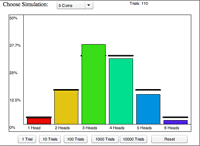Pre-Transition Mathematics
Goals and intended users: Pre-Transition Mathematics is the first book in the UCSMP middle/high school series. Its intended users are students who have already completed a solid fifth-grade curriculum, such as Everyday Mathematics 5, and are ready to tackle a sixth-grade curriculum; or students who have completed a sixth-grade course and need more work before proceeding to a pre-algebra/pre-geometry experience such as that in Transition Mathematics. The goals of Pre-Transition Mathematics are to take an in-depth approach to the arithmetic of rational numbers and to extend the basic ideas of algebra, geometry, probability, and statistics for students from Everyday Mathematics or to introduce these basic ideas for students from non-UCSMP programs who may not have been previously exposed to them. UCSMP provides a series of online demos designed to reinforce key concepts.
Main theme I: To achieve the understanding of arithmetic of rational numbers, students compute with, apply, and picture decimals, percents, fractions, integers, scientific notation, and powers. Special attention is paid to fractions and negative numbers. Students use the basic applications (models) of the operations to solve real-world problems and to see relationships between operations. Pre-Transition Mathematics encourages students to use geometric models in connection with algebraic formulas. Statistical ideas and probability also help students improve on their understanding of rational numbers.
Main theme II: Continuing the emphases of Everyday Mathematics, students of Pre-Transition Mathematics develop the basic ideas of algebra, geometry, probability, and statistics. They continue to use variables in formulas in order to recognize patterns. Students are given the tools they need to solve simple equations and proportions. Using rulers and compasses and dynamic geometry software, students learn to work with the properties of angles, lines, and circles. Statistics continues to show ways to describe distributions and for comparing relative frequency and probability. Students see how to effectively create visual representations to solve mathematical problems using statistical, number line, and coordinate graphs.
Some distinctive lessons: Solving equations with fact triangles (4-7); Deciding whether a decimal terminates or repeats (7-7); Areas of frames and rings (9-5); Statistics from an experiment: Jumping frogs (13-3). A number of games are incorporated into the lessons; some are advanced versions of games students have seen in Everyday Mathematics, others are new.
Comparisons between this and prior editions: This course did not exist in earlier UCSMP editions.
Contact
UCSMP
1427 East 60th Street
Chicago, IL 60637
T: 773-702-1130
F: 773-834-4665
ucsmp@uchicago.edu




